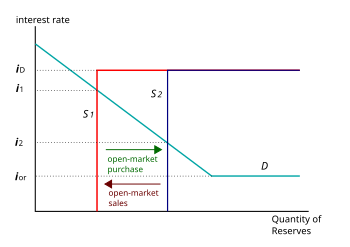
Mechanics of open market operations: Demand-Supply model for reserves market
Classical economic theory postulates a distinctive relationship between the supply of central bank money and short-term interest rates: like for a commodity, a higher demand for central bank money would increase its price, the interest rate. When there is an increased demand for base money, the central bank must act if it wishes to maintain the short-term interest rate. It does this by increasing the supply of base money: it goes to the open market to buy a financial asset, such as
government bonds. To pay for these assets, new central bank money is generated in the seller's loro account, increasing the total amount of base money in the economy. Conversely, if the central bank sells these assets in the open market, the base money is reduced.
Technically, the process works because the central bank has the authority to bring money in and out of existence. It is the only point in the whole system with the unlimited ability to produce money. Another organization may be able to influence the open market for a period of time, but the central bank will always be able to overpower their influence with an infinite supply of money.
[3]
Side note: Countries that have a free floating currency not pegged to any commodity or other currency have a similar capacity to produce an unlimited amount of net financial assets (bonds). Understandably, governments would like to utilize this capacity to meet other political ends like unemployment rate targeting, or relative size of various public services (military, education, health etc.), rather than any specific interest rate. Mostly, however the central bank is prevented by law or convention from giving way to such demands, being required to only generate central bank money in exchange for eligible assets (see above).





0 Comments:
コメントを投稿
<< Home